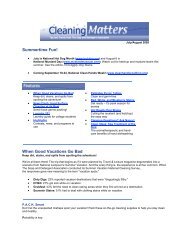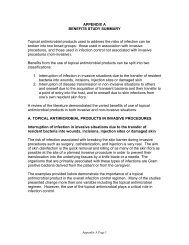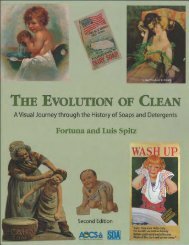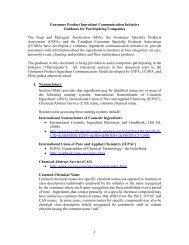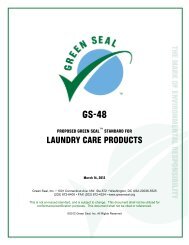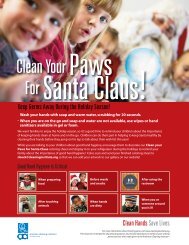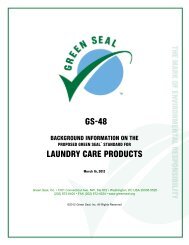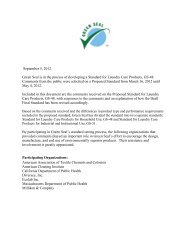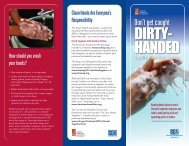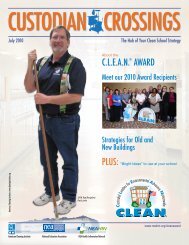subchapter c -- federal hazardous substances act regulations
subchapter c -- federal hazardous substances act regulations
subchapter c -- federal hazardous substances act regulations
You also want an ePaper? Increase the reach of your titles
YUMPU automatically turns print PDFs into web optimized ePapers that Google loves.
§ 1500.50 Test methods for simulating use<br />
and abuse of toys and other articles<br />
intended for use by children.<br />
(a) Objective. The objective of §§ 1500.51,<br />
1500.52, and 1500.53 is to describe specific<br />
test methods for simulating normal use of toys<br />
and other articles intended for use by children<br />
as well as the reasonably foreseeable damage<br />
or abuse to which the articles may be<br />
subjected. The test methods are for use in<br />
exposing potential hazards that would result<br />
from the normal use or the reasonably<br />
foreseeable damage or abuse of such articles<br />
intended for children.<br />
(b) Application—general. (1)(i) The test<br />
methods described in §§ 1500.51, 1500.52 and<br />
1500.53 are to be used in determining what is<br />
normal use and reasonably foreseeable damage<br />
or abuse when specifically referenced under §<br />
1500.18. Other banning <strong>regulations</strong> may also<br />
reference these use and abuse toy test<br />
procedures.<br />
(ii) The test methods described in §§<br />
1500.51, 1500.52, and 1500.53 have been<br />
established for articles intended for the<br />
specified age groups of children: 18 months of<br />
age or less, over 18 months but not over 36<br />
months of age, and over 36 months but not<br />
over 96 months of age. If an article is marked,<br />
labeled, advertised, or otherwise intended for<br />
children of ages spanning more than one of<br />
these age groups, the article will be subjected<br />
to the tests providing the most stringent<br />
requirements. If an article is not age-labeled in<br />
a clear and conspicuous manner or, based on<br />
such f<strong>act</strong>ors as marketing pr<strong>act</strong>ices and the<br />
customary patterns of usage of a product by<br />
children, is inappropriately age-labeled, and is<br />
intended or appropriate for children 96 months<br />
of age or less, it will also be subjected to the<br />
most stringent test requirements.<br />
(2) For purposes of compliance with the<br />
test methods prescribed in §§ 1500.51,<br />
1500.52, and 1500.53, the English system<br />
shall be used. The metric approximations are<br />
provided in parentheses for convenience and<br />
information only.<br />
(3) Each of the test methods described in<br />
§§ 1500.51, 1500.52, and 1500.53 shall be<br />
applied to a previously untested sample except<br />
the tension test which shall be conducted with<br />
the test sample used in the torque test.<br />
(4) Prior to testing, each sample shall be<br />
subjected to a temperature of 73°±3 °F. (23°±2<br />
16 CFR Ch. II (1–1–05 Edition)—proposed modificication – 6/25/06<br />
-- 57 --<br />
°C.) as a relative humidity of 20-70 percent for<br />
a period of at least 4 hours. The toy testing<br />
shall commence within five minutes after the<br />
toy has been removed from the<br />
preconditioning atmosphere.<br />
(5) Toys reasonably intended to be<br />
assembled by an adult and not intended to be<br />
taken apart by a child shall be tested only in<br />
the assembled state if the shelf package and<br />
the assembly instructions prominently indicate<br />
that the article is to be assembled only by an<br />
adult.<br />
(6) Toys intended to be repeatedly<br />
assembled and taken apart shall have the<br />
individual pieces as well as the completed<br />
article subjected to these test procedures.<br />
(7) In situations where a test procedure<br />
may be applied in more than one way to a toy<br />
test component, the point (or direction) of<br />
force (or torque) application which results in<br />
the most severe conditions shall be used.<br />
(c) Definitions. As used in this section and<br />
in §§ 1500.51, 1500.52, and 1500.53:<br />
(1) Toy means any toy, game, or other<br />
article designed, labeled, advertised, or<br />
otherwise intended for use by children.<br />
(2) Mouth toy means any toy reasonably<br />
intended to be placed into or in cont<strong>act</strong> with a<br />
child’s mouth.<br />
§ 1500.51 Test methods for simulating use<br />
and abuse of toys and other articles<br />
intended for use by children 18 months of<br />
age or less.<br />
(a) Application. The test methods<br />
described in this section shall be used to<br />
simulate the normal and reasonably<br />
foreseeable use, damage, or abuse of toys and<br />
other articles intended for use by children 18<br />
months of age or less in conjunction with §<br />
1500.18.<br />
(b) Imp<strong>act</strong> test—(1) Application. Except as<br />
provided in paragraph (b)(4) of this section,<br />
toys having a weight of less than 3.0 pounds<br />
±0.01 pound (1.4 kilograms) shall be subject<br />
to this test.<br />
(2) Imp<strong>act</strong> medium. The imp<strong>act</strong> medium<br />
shall consist of a 1⁄8-inch (0.3-centimeter)<br />
nominal thickness of type IV vinylcomposition<br />
tile, composition 1 — asbestos<br />
free, as specified by paragraphs 1.2 and 3.1.4<br />
of Interim Amendment-1(YD), dated<br />
November 14, 1979, to the Federal<br />
Specification entitled Tile, Floor: Asphalt,



